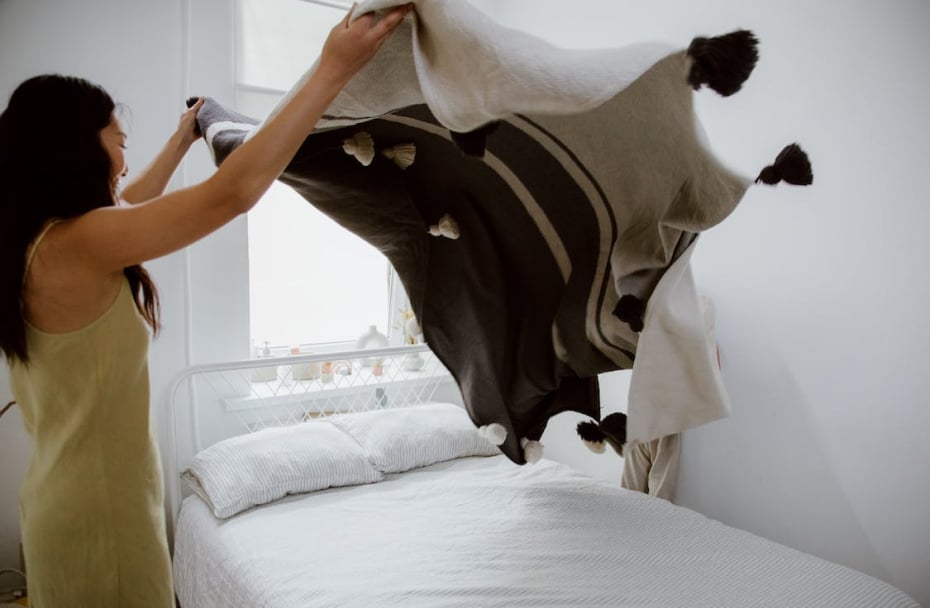

Washing a mattress protector might not top your list of exciting chores, but it's absolutely essential for keeping your sleeping chambers as clean and healthy as possible. So naturally, investing in a high-quality protector is a really smart move for anyone looking to prolong the life of their mattress and maintain a cozy and fresh sleeping haven. Are mattress protectors best washable by hand or machine? Knowing exactly how to wash a mattress protector is crucial in helping you avoid a messy situation. In this guide, we'll walk you through the process and make sure you never have to deal with the headache of a dirty mattress ever again.
Key Takeaways
- Regular washing of mattress protectors is essential for allergen removal and bedroom cleanliness.
- Different materials require specific washing approaches, including choice of detergent and water temperature.
- Targeted stain removal with enzyme-based cleaners is key for tough stains.
- Monthly or bi-monthly washing is recommended, but more often for allergy sufferers, using machine or manual methods.
- Proper drying and storage are critical to ensure a long-living and effective mattress protector.
How to Prepare for Washing Your Mattress Protector
Before diving into the task at hand, let's get our ducks in a row. Identifying the issue and understanding what you're up against is the first step. Is it a morning coffee accident, an unexpected spill, or perhaps a concern about lurking allergens? Once you've sized up the situation, gather the necessary products and tools, including laundry detergent, a soft brush, a mild stain remover, and, of course, your mattress protector.
Now, you might be wondering, "Can I just toss it in the laundry with my dirty socks?" “Should I wash my new mattress protector before use?” Hold your horses. Depending on the issue at hand, your approach will differ. Let's break it down.
Identifying The Issue
Your mattress protector faces a battlefield of invisible and unexpected nasties, from morning coffee and croissant crumbs to the unseen menace of dust mites that can trigger your allergies. Identifying the issue is crucial because, as they say, knowing is half the battle:
- Spills and Stains: Life is full of those everyday mishaps, whether it's a morning coffee mishap or an accidental bedtime snack. Cleaning your mattress protector is essential to prevent these stains from settling in and becoming permanent blemishes.
- Allergen Build-Up: As time goes on, your mattress protector can collect pesky allergens, with dust mites taking center stage. Regular washing is your defense against these tiny creatures that can worsen allergies and respiratory issues.
- Body Oils and Sweat: We all naturally produce oils and sweat while catching some Zs. Even though mattress protectors act as a barrier, they can still soak up these bodily fluids, leading to unpleasant odors and potential yellow stains. Knowing how to get the sweat smell out of a mattress ensures a fresh and hygienic sleep surface.
- Pet-Related Nasties: For those with furry friends sharing the bed, pet dander and fleas can contribute to the need for frequent cleaning. If you’re asking yourself the question: “What can I spray on my mattress to kill fleas?” then look no further.
- General Wear and Tear: The daily grind can take its toll, impacting the effectiveness of your mattress protector over time. Cleaning becomes a necessity to maintain the fabric's integrity and ensure your mattress stays protected.
- Illness or Infections: During bouts of illness or infections, your mattress protector can become a breeding ground for bacteria. Regular washing, especially after recovering from an illness, helps kick those lingering germs to the curb and keeps your sleep sanctuary germ-free.
- Environmental Factors: Humidity and temperature changes can create an environment ripe for mold and mildew on your mattress protector. Proper cleaning is your ticket to preventing these issues and ensuring your sleep space remains healthy.
- Accidental Damage: Life is unpredictable, and sometimes your mattress protector might face accidental damage – be it a snag, tear, or other unintentional harm. Cleaning gives you the chance to assess and address any damage promptly, keeping your protector in top-notch condition.
To combat these issues effectively, it's crucial to understand the specifics of your mattress protector. Is it waterproof? Does it have any unique features that require special attention? Identifying the issue is the first step toward a successful cleaning routine.
What Tools And Products You Will Need
Now that you've identified the issue let's gather the tools and products you'll need for the task at hand:
- Laundry Detergent: Choose a mild, hypoallergenic detergent to protect against skin irritation.
- Soft Brush: Ideal for gently scrubbing away stains without damaging the protector's fabric.
- Mild Stain Remover: For tougher stains, a gentle enzyme-based stain remover can be a game-changer.
- Water: Whether you opt for cold or hot water depends on the care instructions for your specific mattress protector.
- Air Dry Space: Ensure you have a well-ventilated area for drying, whether it's outdoors or in a room with good airflow. Knowing the exact process of how to dry a mattress is essential.
- Baking Soda: For a more hands-on approach, a soft brush and a mixture of baking soda and water make a formidable team. Together, they'll banish stains and odors, leaving your protector smelling as fresh as a morning breeze. Be sure to get yourself up to speed on how to get any smell out of your mattress by following our guide.
With these tools in hand, you're ready to tackle the cleaning process and keep your mattress protector in top-notch condition.
How Often Do You Need to Wash Your Mattress Protector?
Do you need to wash mattress protectors every day? The frequency of how often to wash your mattress protector boils down to your own personal preference and the specific issues you're dealing with. However, as a general rule of thumb, washing your mattress protector every 1-2 months is adequate. If you're dealing with spills or noticeable stains, it's wise to address them promptly to prevent long-term damage.
Regular washing not only maintains cleanliness but also keeps you in control when it comes to allergens. Dust mites, in particular, thrive in unwashed bedding, contributing to allergies and breathing issues. By adhering to a proper cleaning schedule, you create a healthier sleeping environment for yourself.
How to Wash Your Mattress Cover in a Washing Machine
Can you wash a mattress cover or protector in a washing machine? - the answer is a resounding yes. Here's a step-by-step guide on how to wash your mattress protector or cover in a washing machine:
Check the Care Label
Before anything else, familiarize yourself with the mattress protector washing instructions provided by the manufacturer. This ensures you're using the right water temperature and washing settings.
Strip the Bed
Remove the mattress protector from the bed and shake off any loose debris. This step is crucial to prevent the washing machine from becoming overloaded.
Close Zippers and Fastenings
Ensure all zippers and fastenings are securely closed to prevent any damage during the washing process.
Choose the Right Detergent:
Add a mild, hypoallergenic detergent to the washing machine. Avoid using bleach or harsh chemicals that could compromise the integrity of the protector.
Into the Machine It Goes
Choose a gentle cycle with cold or warm water, depending on the care instructions. High heat can damage certain materials and affect the waterproofing capabilities of the protector.
Select the Right Cycle
What is the best temperature to wash my mattress protector? Choose a gentle cycle with cold or warm water, depending on the care instructions. High heat can damage certain materials and affect the waterproofing capabilities of the protector. Knowing how to wash a mattress protector that’s waterproof is imperative.
Low Heat, Please
Once the washing cycle is complete, resist the temptation to use high heat for drying. Opt for air drying or a low-heat setting to preserve the quality of the fabric.
Remember, the key here is consistency. Make washing your mattress protector a routine, and you'll reap the benefits of a cleaner and more hygienic sleeping environment.
How to Clean Your Mattress Protector Manually
Can mattress covers be washed by hand? In some cases, you might prefer or need to clean your mattress protector manually. This hands-on method is especially useful for spot cleaning or addressing specific stains. Here's our step-by-step guide:
Spot Check for Stains
It’s time to play Sherlock and identify the areas that require cleaning and spot check for stains. This will help you determine if any specialized stain removal products are necessary.
Prepare a Cleaning Solution
Mix a small amount of mild detergent with water to create a soapy solution. For tougher stains, consider adding a mild stain remover to the mix.
Gently Scrub Stains
Dip a soft brush or cloth into the soapy solution and gently scrub the stained areas. Take care not to scrub too vigorously, as this can damage the fabric.
Rinse Thoroughly
Once the stains are treated, rinse the entire mattress protector thoroughly with clean water. Ensure all soap and cleaning solution residues are washed away.
Air Dry
Know how to dry a mattress protector to avoid any possible heat damage. Allow it to air dry in a well-ventilated space. Avoid direct sunlight, as prolonged exposure can affect the color and fabric.
How to Remove Stains From Your Mattress Protector
Stains on a mattress protector can be unsightly and, if left untreated, may lead to odors and damage. Here's a guide on how to remove stains effectively:
Jump into Action
The sooner you address a stain, the easier it is to remove. Act quickly to prevent the stain from setting into the fabric.
Blot, Don't Rub
When dealing with liquid stains, such as spills or bodily fluids, blot the area with a clean cloth instead of rubbing. Rubbing can spread the stain and damage the fabric. A gentle scrub can also do the trick.
Use a Stain Remover
Apply a mild stain remover directly to the stained area. Follow the product's instructions, and avoid using excessive amounts.
Rinse and Repeat
After treating the stain, rinse the area with cold water and pat dry. If the stain persists, repeat the process until victory is yours.
Tips on Keeping Your Mattress Protector Fresh And Clean
Maintaining the freshness and cleanliness of your mattress protector involves more than just periodic washing. Consider these tips for an extra layer of care:
Use a Mattress Pad
Place a mattress pad over your mattress protector for an additional barrier against spills and stains. This extra layer is easier to wash and can extend the lifespan of your mattress protector. Furthermore, knowing how to wash a mattress pad will be sure to set you up for success in your struggles.
Rotate Your Mattress Protector
If your mattress protector has a specific top and bottom, rotate it regularly to ensure even wear. This prevents one side from bearing the brunt of daily use.
Vacuum Regularly
Dust mites and allergens can accumulate on your mattress protector. Vacuum it regularly to remove these particles and keep your sleeping environment as clean as possible.
Sun Exposure
Occasionally, expose your mattress protector to sunlight. UV rays can help kill bacteria and dust mites, providing a natural and effective way to refresh your protector.
Frequently Asked Questions
Can you put a mattress protector in the dryer?
Yes, you can, but it's advisable to use a low-heat setting or opt for air drying. High heat can compromise the waterproofing features and overall quality of the mattress protector.
Why are there yellow stains on my mattress protector?
Ah, those confusing and ugly yellow stains—the aftermath of sweat and body oils, amongst other things. Fear not, though; a mix of cold water and baking soda can vanquish these stains for good. Just follow our stain-removal guide, and you’re sure to become a pro at how to get yellow stains out of your mattress.
How long do mattress protectors last?
The lifespan of a mattress protector depends on factors such as material, usage, and care. On average, a high-quality protector can last anywhere from 3 to 5 years, but following our tips could get you into the healthy range of 5 to 10 years.
Are mattress protectors waterproof?
You’ll find that many of the mattress protectors on the market are indeed waterproof. Just use that keen eye of yours to always check the label and confirm it. Waterproof protectors are amazing for preventing liquid damage, especially in households with children or pets.
Can bed bugs get through a zippered mattress protector?
Don’t let the bed bugs bite... So to speak. Owning a zippered mattress protector provides an additional barrier against bed bugs. Just be sure to check the label and get a high-quality one.
![How to Get Vomit Out of Your Mattress [Stain & Smell Solutions]](/storage/web/source/1/pL6ZIMCmAC97BEyoEjQfP86wJt2XjC5B.jpg)
![How to Get Sweat Smell Out of Your Mattress: [Clean Sleep]](/storage/web/source/1/DnSNEP7a--FLKDtoGY80VXUjg9tg0nrx.jpg)
![How to Get Yellow Stains Out of Your Mattress [Effective Tips]](/storage/web/source/1/kD-X9LJnVrpGB7pcWsf88L-h3iFv9eBk.jpg)

